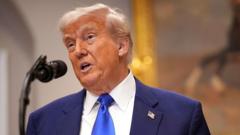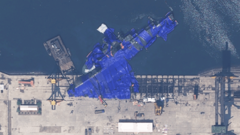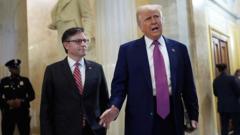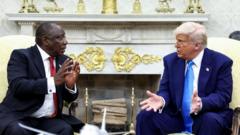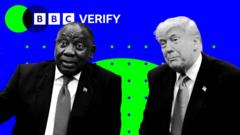In a move that has surprised many in the West, Russia was notably absent from former President Donald Trump’s recent list of tariffs imposed on trade partners. Local media have expressed disappointment, with reports highlighting the rationale provided by White House Press Secretary Karoline Leavitt. She stated that pre-existing sanctions against Russia, implemented following its 2022 invasion of Ukraine, have essentially eliminated meaningful trade opportunities. Alongside Russia, countries like Cuba, Belarus, and North Korea were also excluded from the tariff list due to similar trade constraints.
Trump's Tariff List Excludes Russia, Surprising Many in the West

Trump's Tariff List Excludes Russia, Surprising Many in the West
The absence of Russia from Donald Trump's recent tariff list is causing disappointment among Western observers, as existing sanctions render significant trade impossible.
Despite its current low trade volume with the US—approximately $3.5 billion in 2024, primarily consisting of fertilizers and metals—other countries with even lesser trade, like Syria, were included in the tariff scheme. Russian media, interpreting the situation through a nationalistic lens, remarked that the exclusion from the tariffs is less about preferential treatment and more about the effectiveness of Western sanctions.
Amid the discussions surrounding tariffs, Trump’s administration is actively seeking to end the war in Ukraine, which they have since made a priority. As negotiations persist, a top Russian official is currently in Washington as talks on a possible resolution are underway. Trump previously hinted at imposing a hefty 50% tariff on nations purchasing Russian oil unless a ceasefire is established.
Russian media responses have varied, with some adopting a mocking tone, criticizing the treatment of US allies in Europe and even lampooning the inclusion of uninhabited territories like Heard Island, reflecting a lighter approach amid serious geopolitical matters. Meanwhile, Ukraine, facing a new 10% tariff on its exports to the US, expressed concerns about the potential impacts on small producers, while also emphasizing its importance as a strategic ally to the United States.
Despite being sidelined from trade discussions, the US continues to support Ukraine materially in its conflict with Russia, with total aid reaching significant figures, as articulated by both Trump and US defense authorities.
This dynamic between tariffs and geopolitical alliances continues to evolve as nations adapt their strategies in light of ongoing conflicts and established trade relationships.
Amid the discussions surrounding tariffs, Trump’s administration is actively seeking to end the war in Ukraine, which they have since made a priority. As negotiations persist, a top Russian official is currently in Washington as talks on a possible resolution are underway. Trump previously hinted at imposing a hefty 50% tariff on nations purchasing Russian oil unless a ceasefire is established.
Russian media responses have varied, with some adopting a mocking tone, criticizing the treatment of US allies in Europe and even lampooning the inclusion of uninhabited territories like Heard Island, reflecting a lighter approach amid serious geopolitical matters. Meanwhile, Ukraine, facing a new 10% tariff on its exports to the US, expressed concerns about the potential impacts on small producers, while also emphasizing its importance as a strategic ally to the United States.
Despite being sidelined from trade discussions, the US continues to support Ukraine materially in its conflict with Russia, with total aid reaching significant figures, as articulated by both Trump and US defense authorities.
This dynamic between tariffs and geopolitical alliances continues to evolve as nations adapt their strategies in light of ongoing conflicts and established trade relationships.



